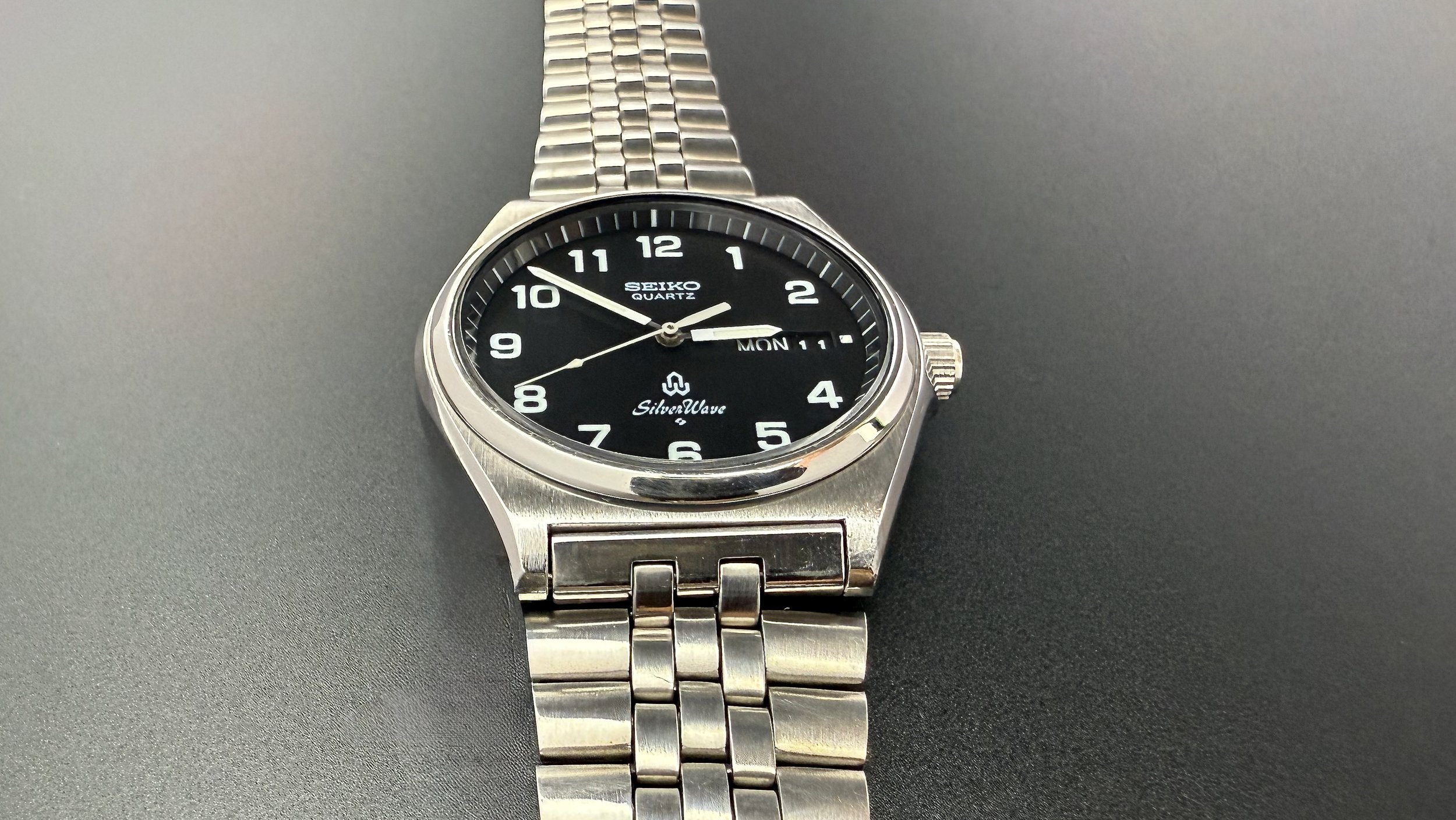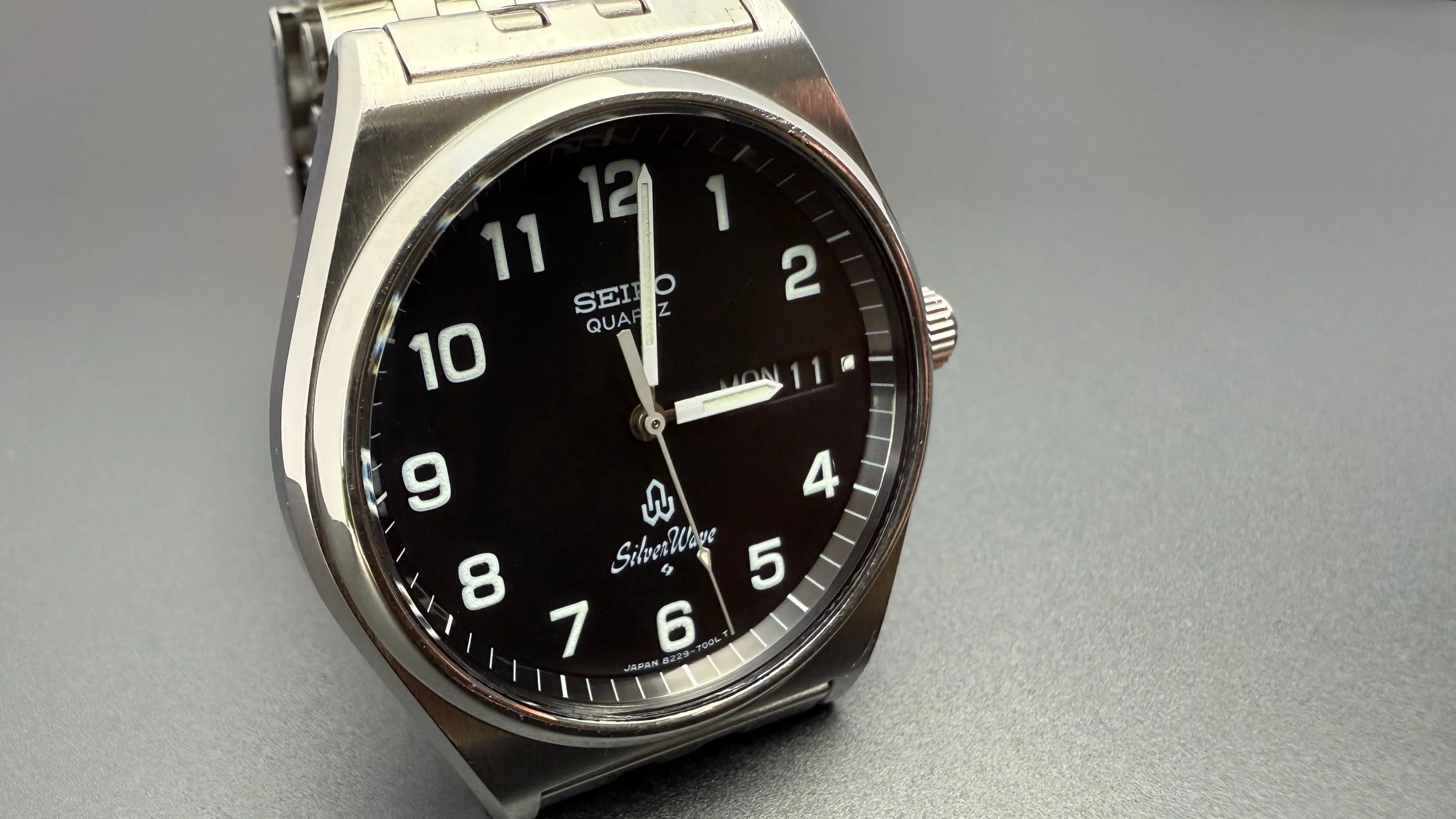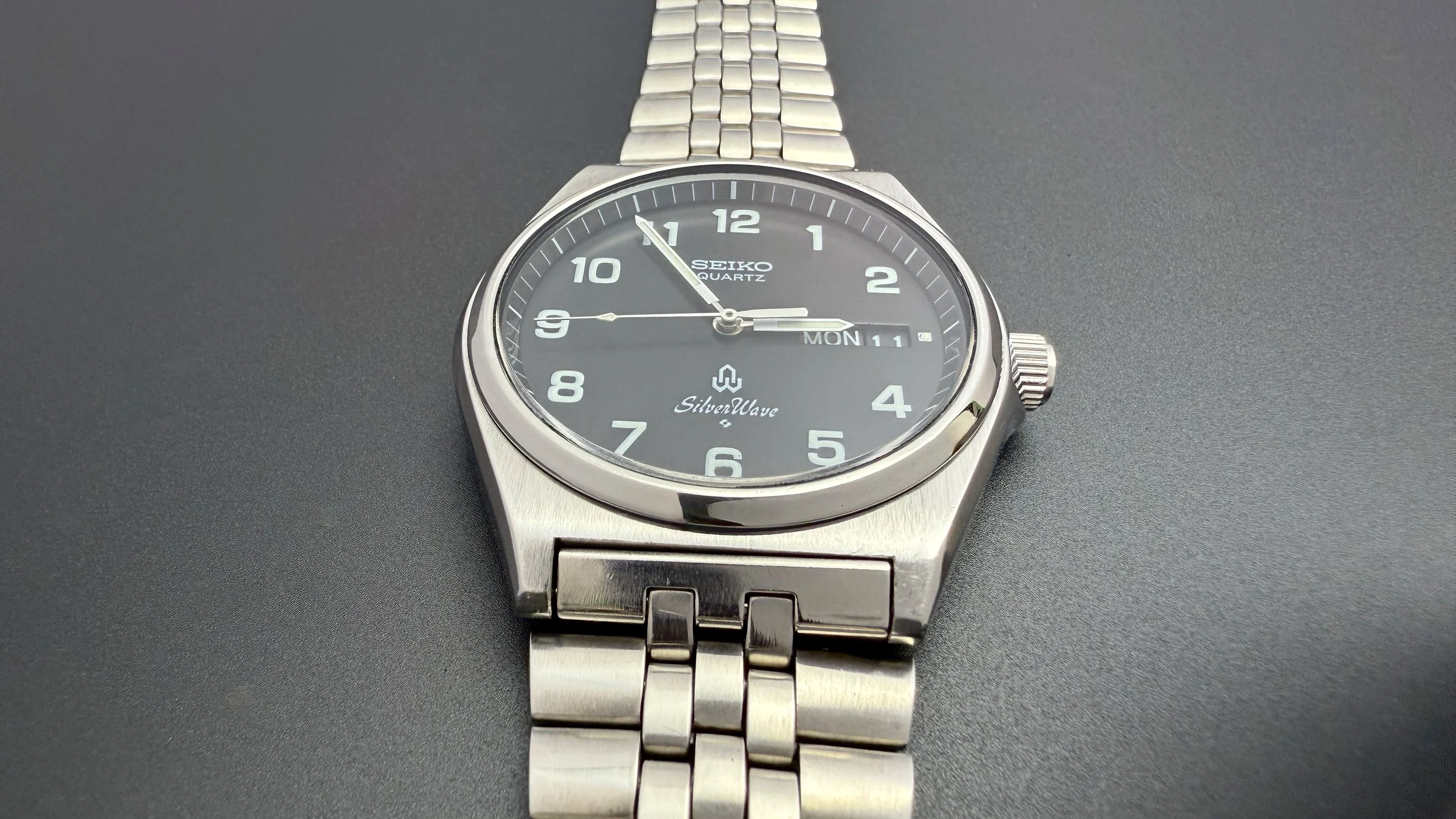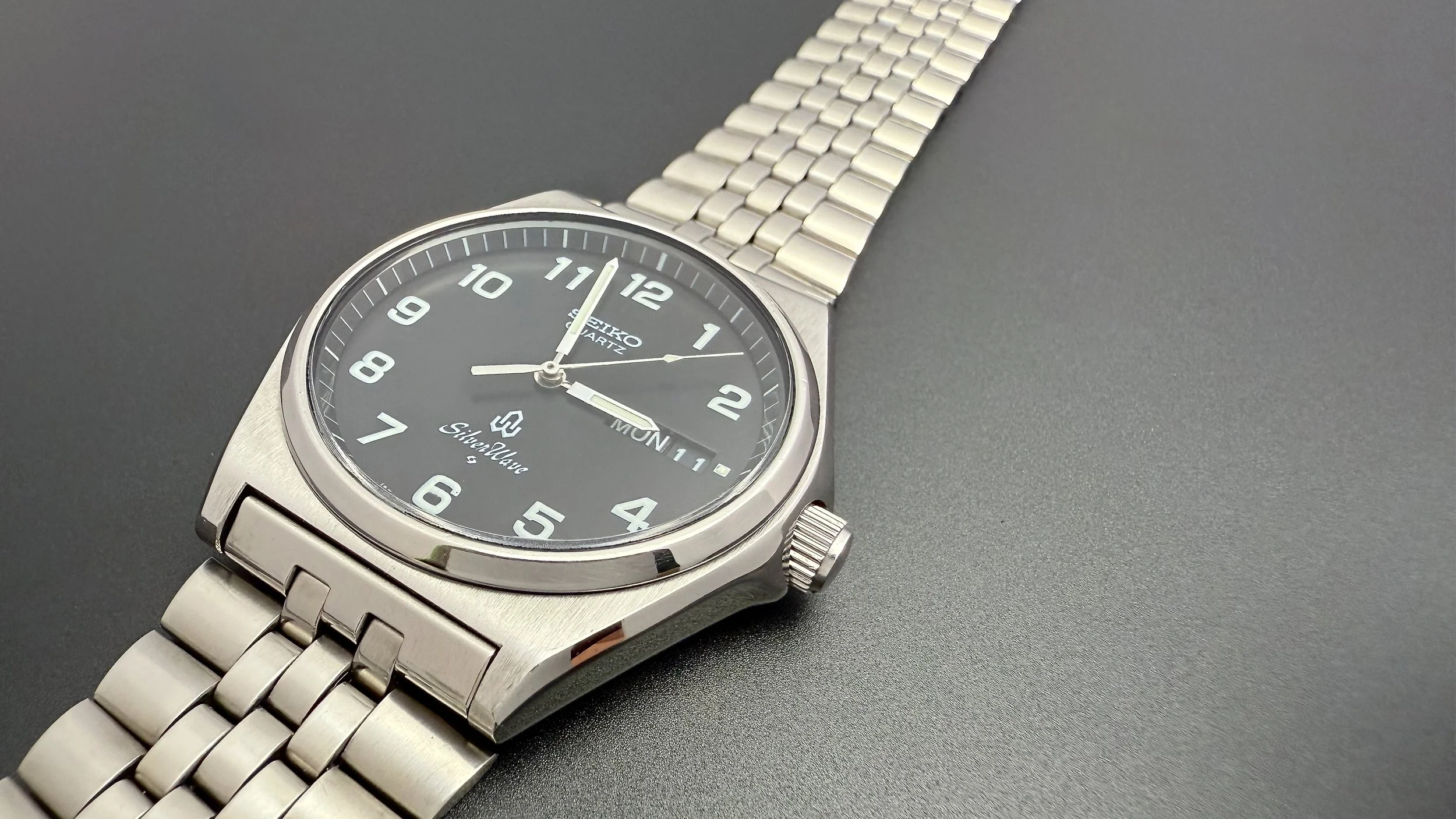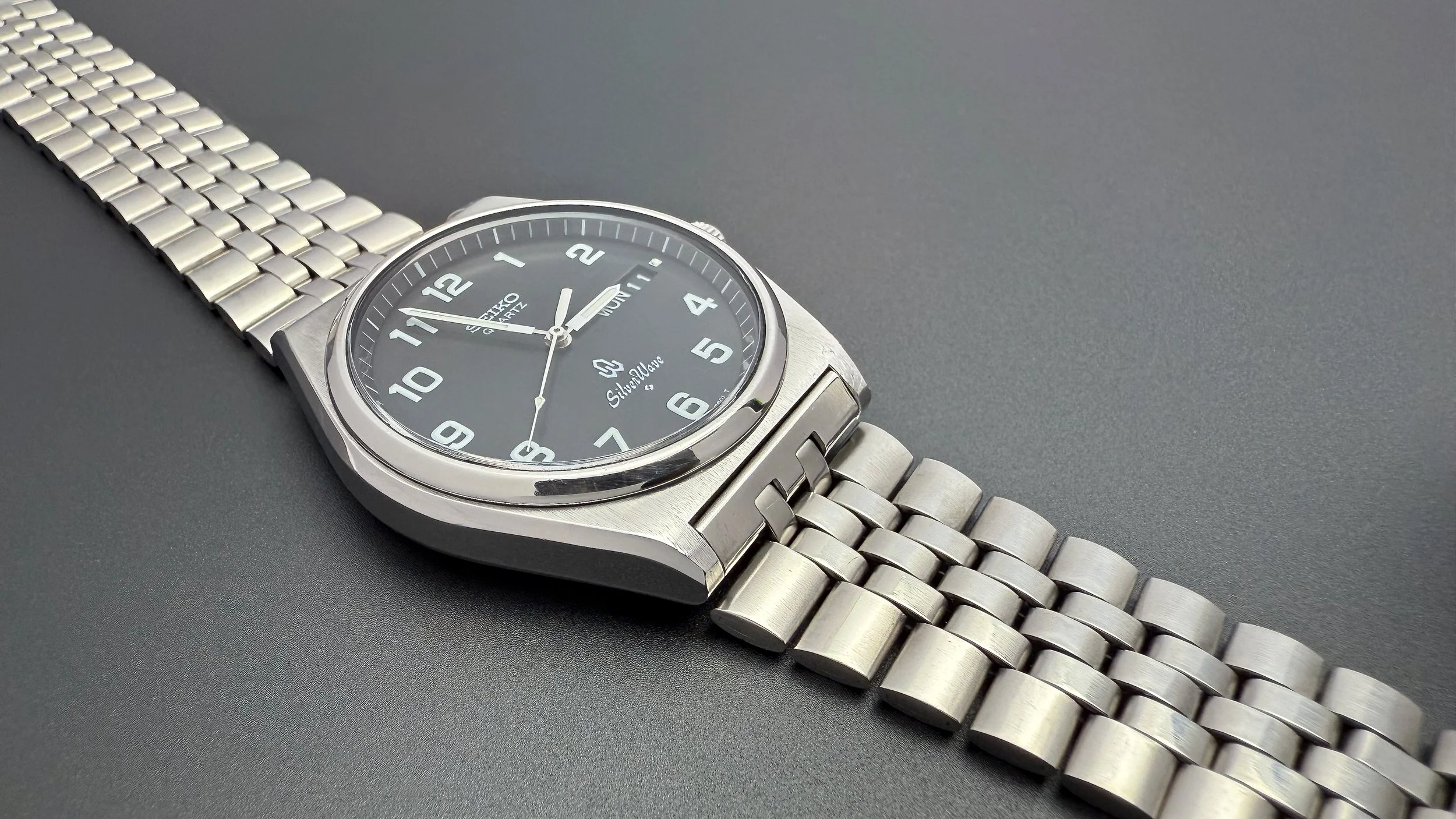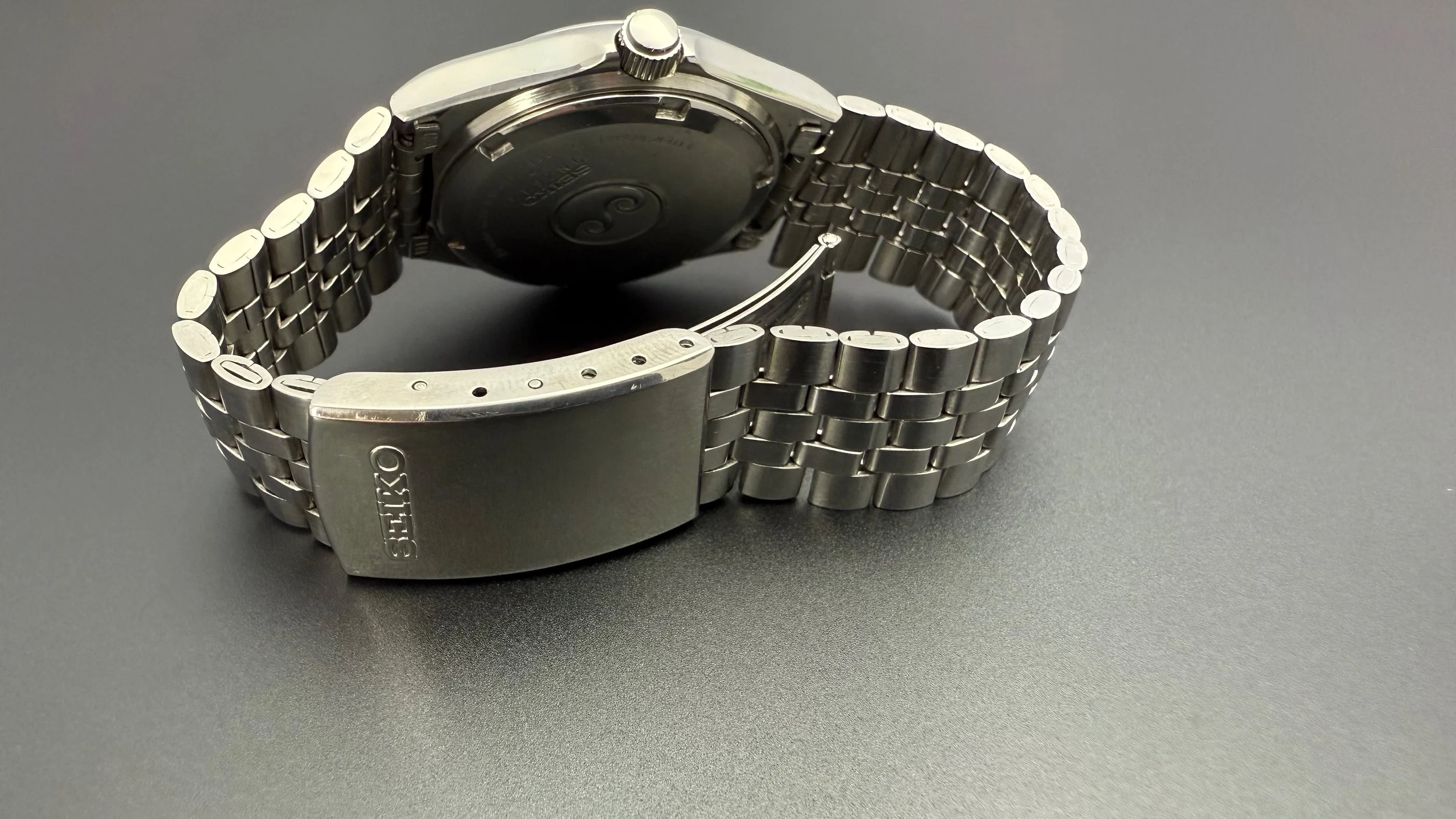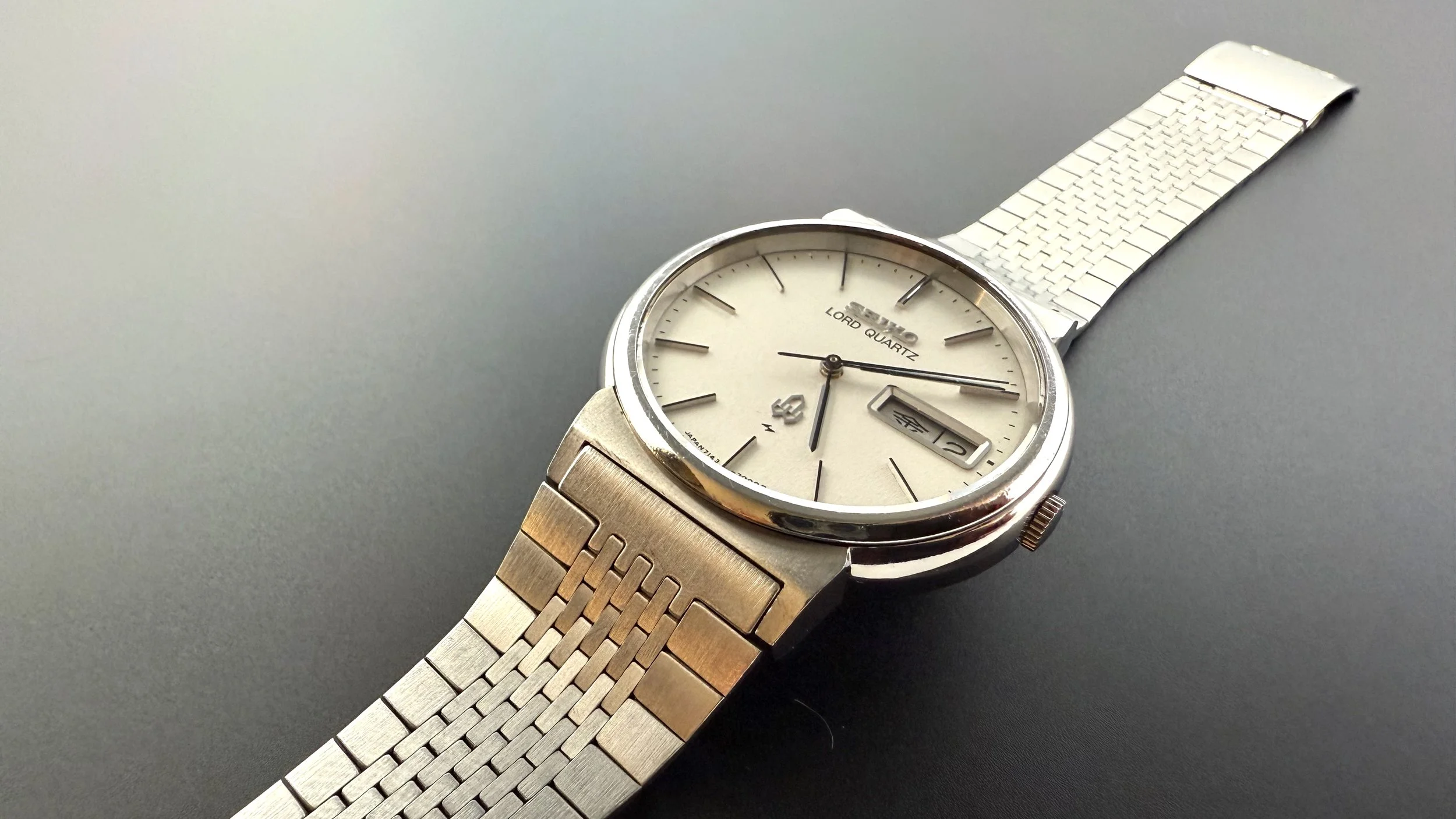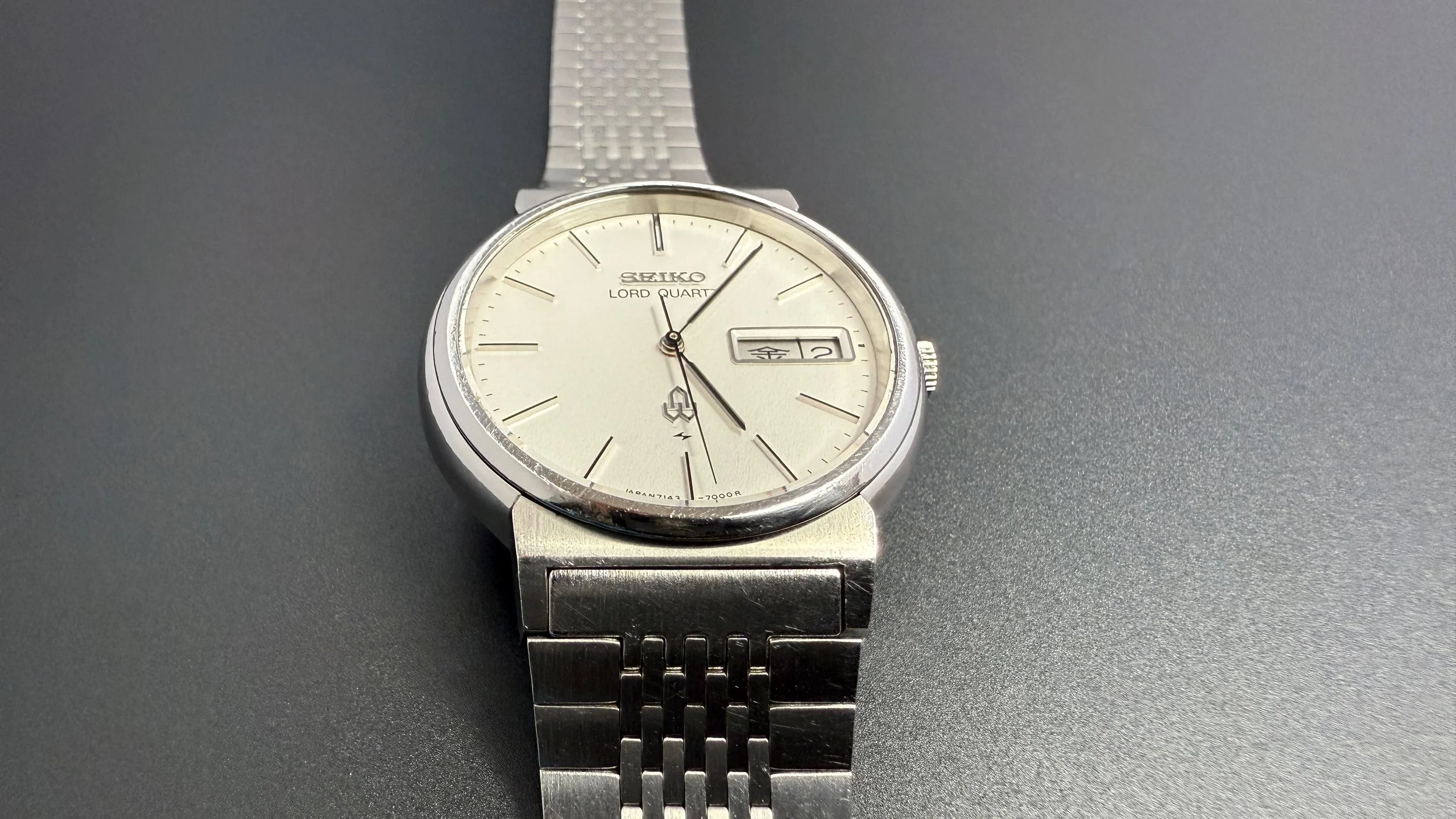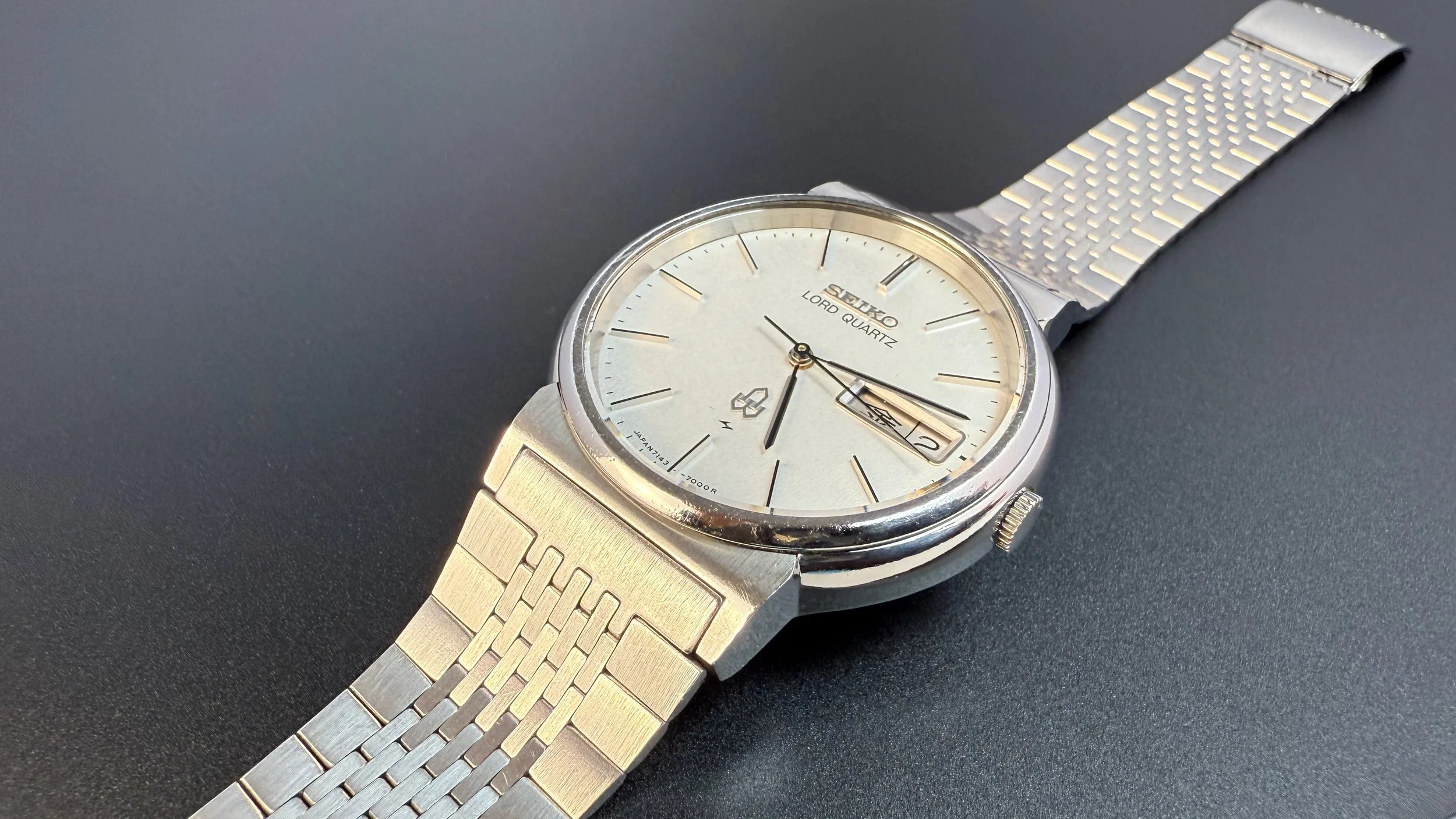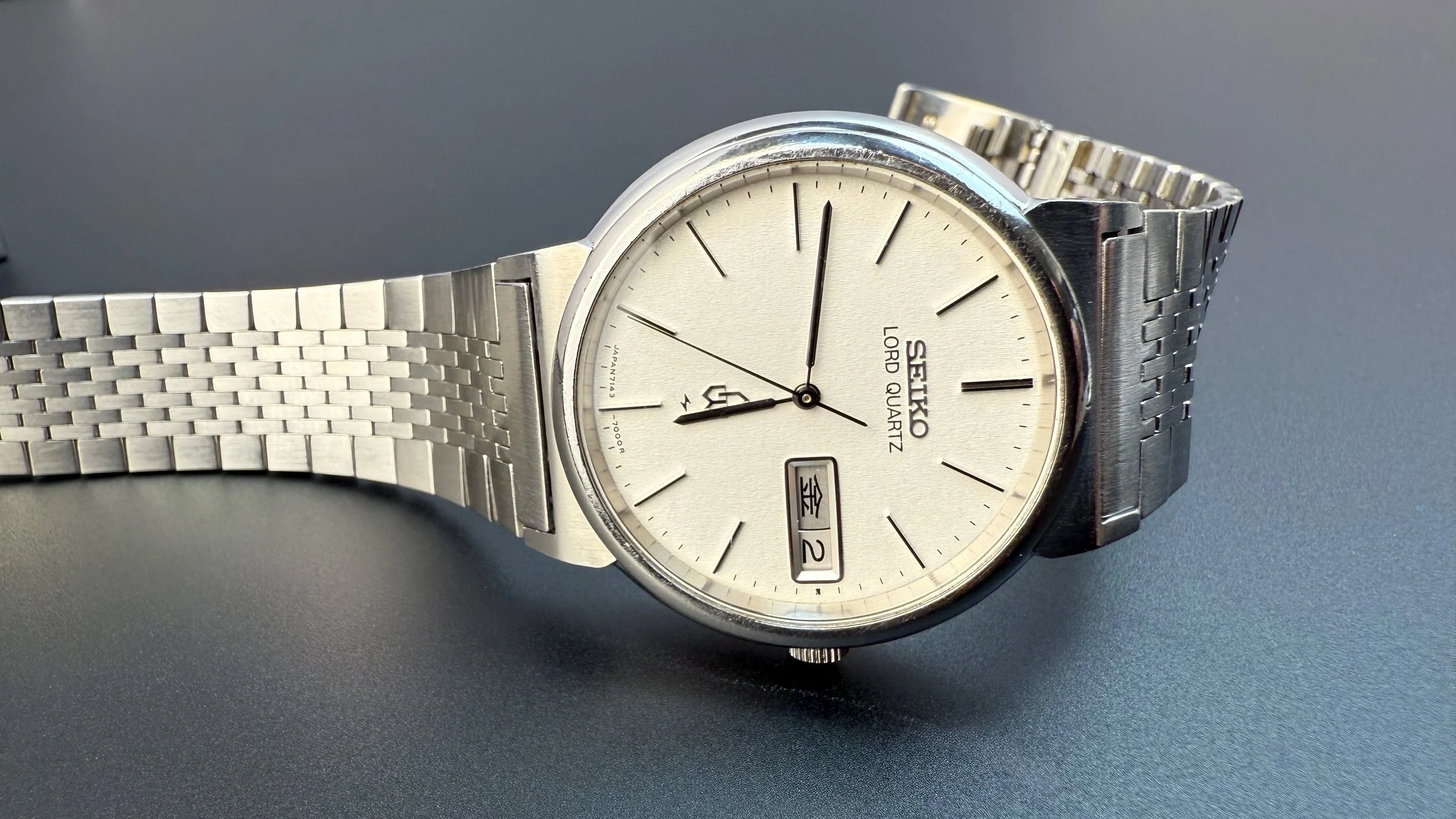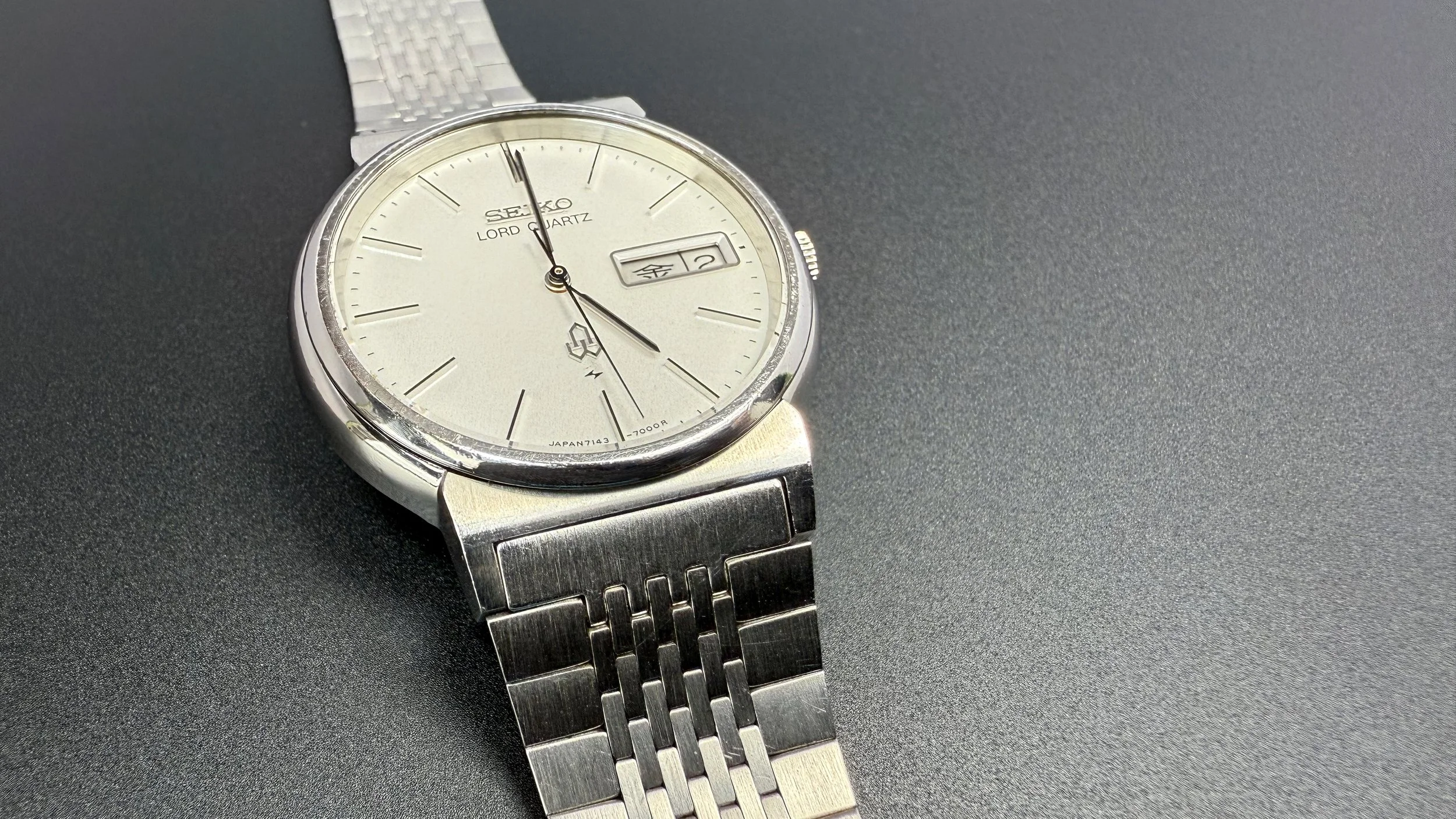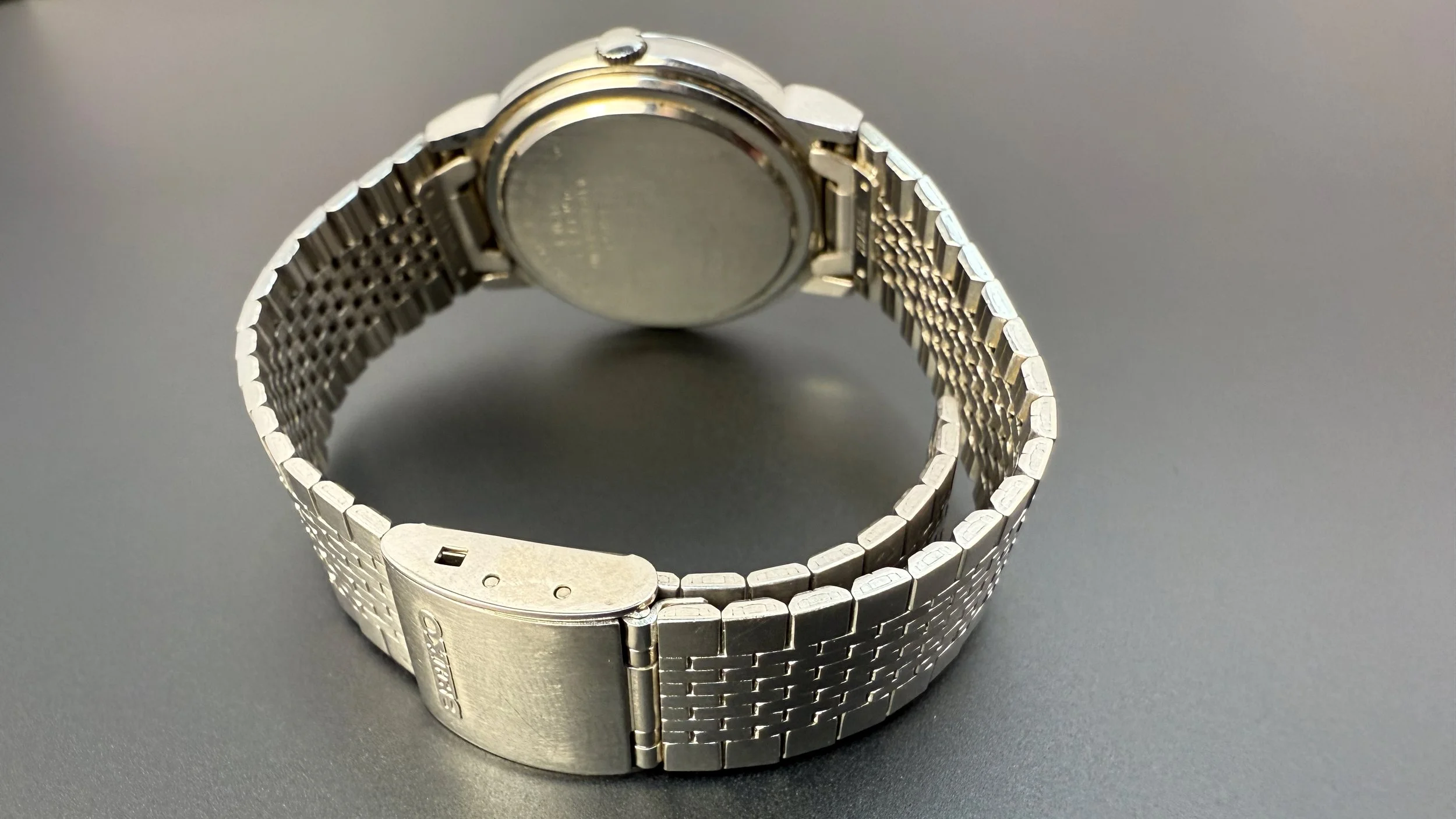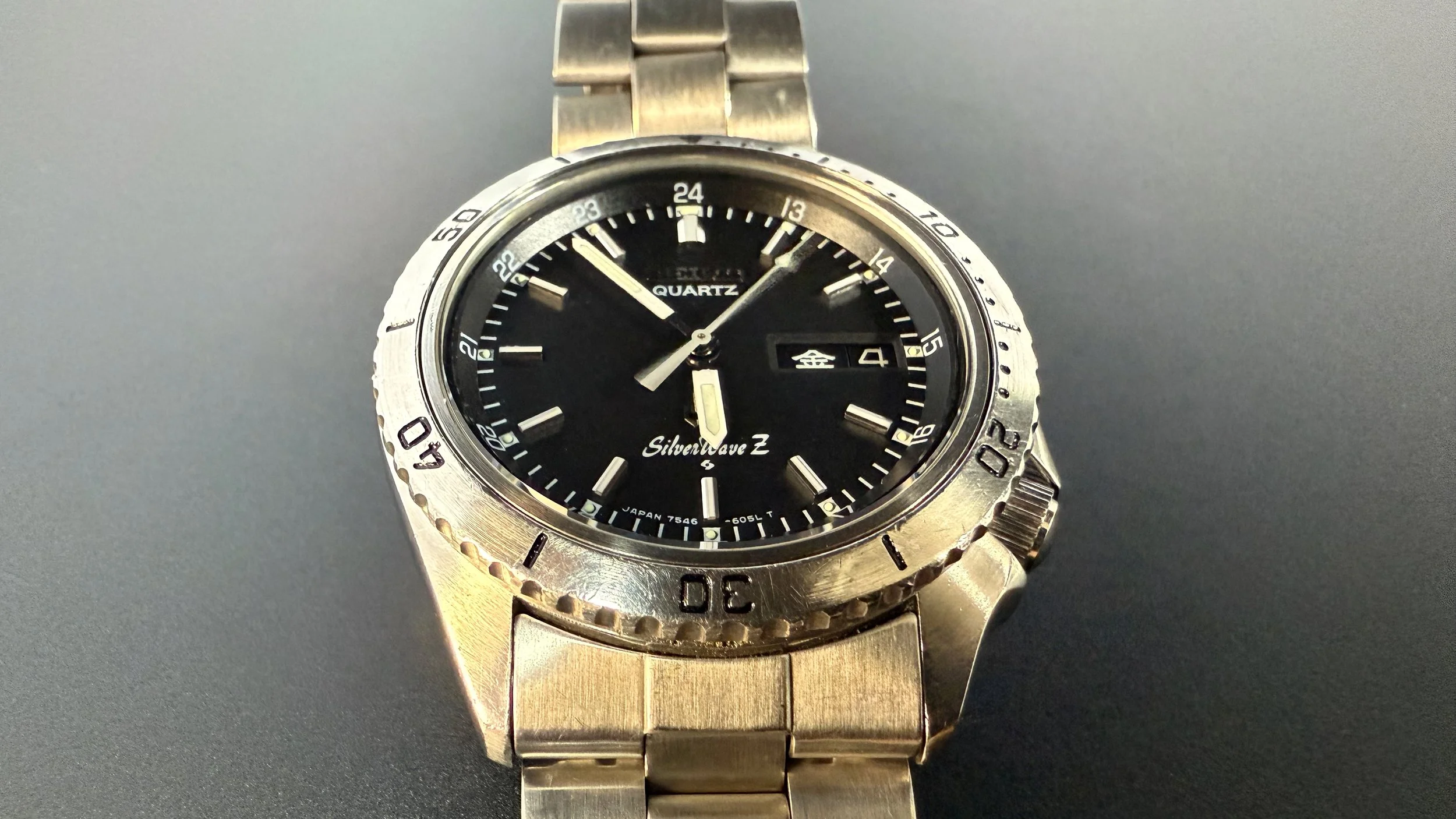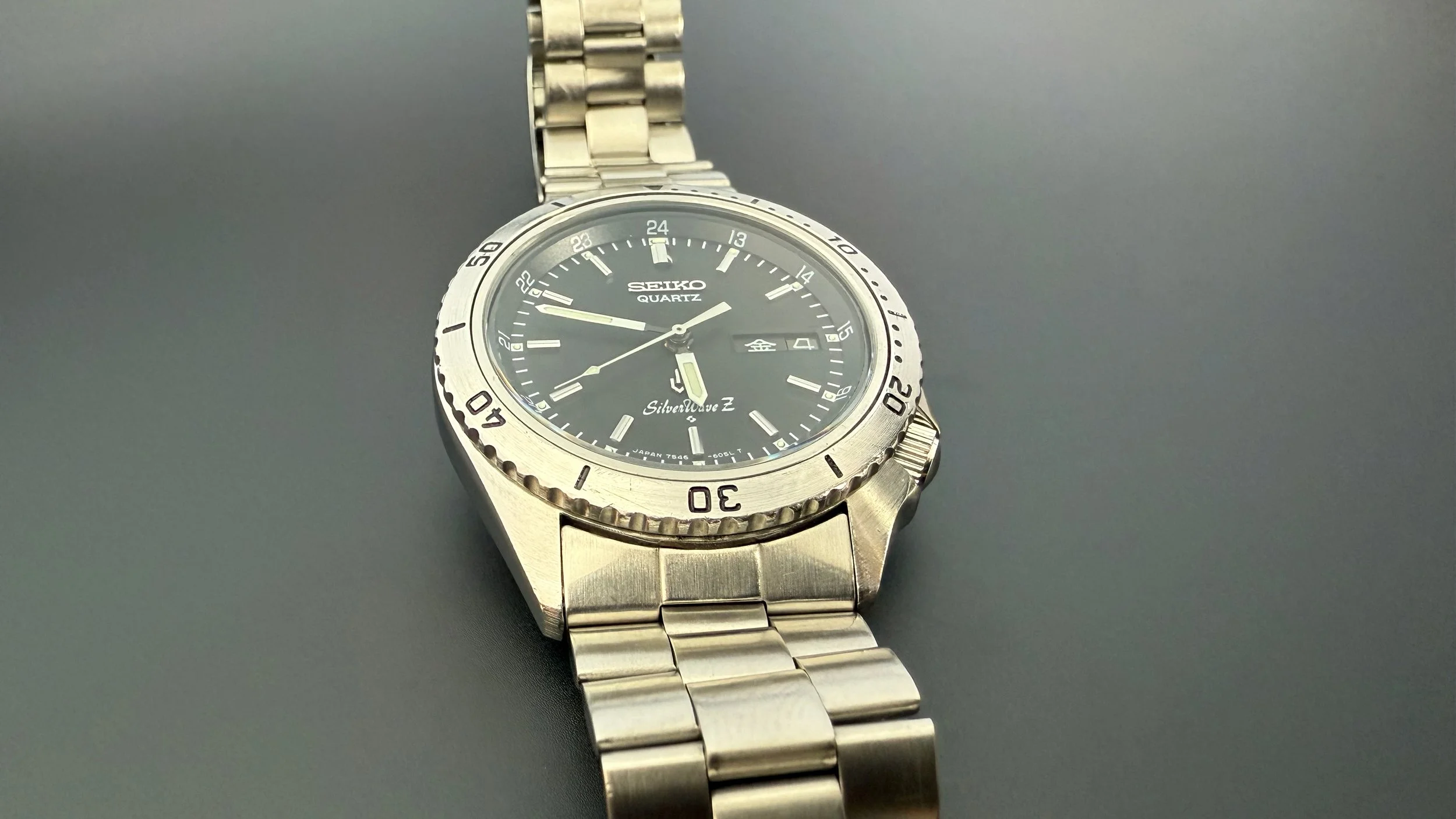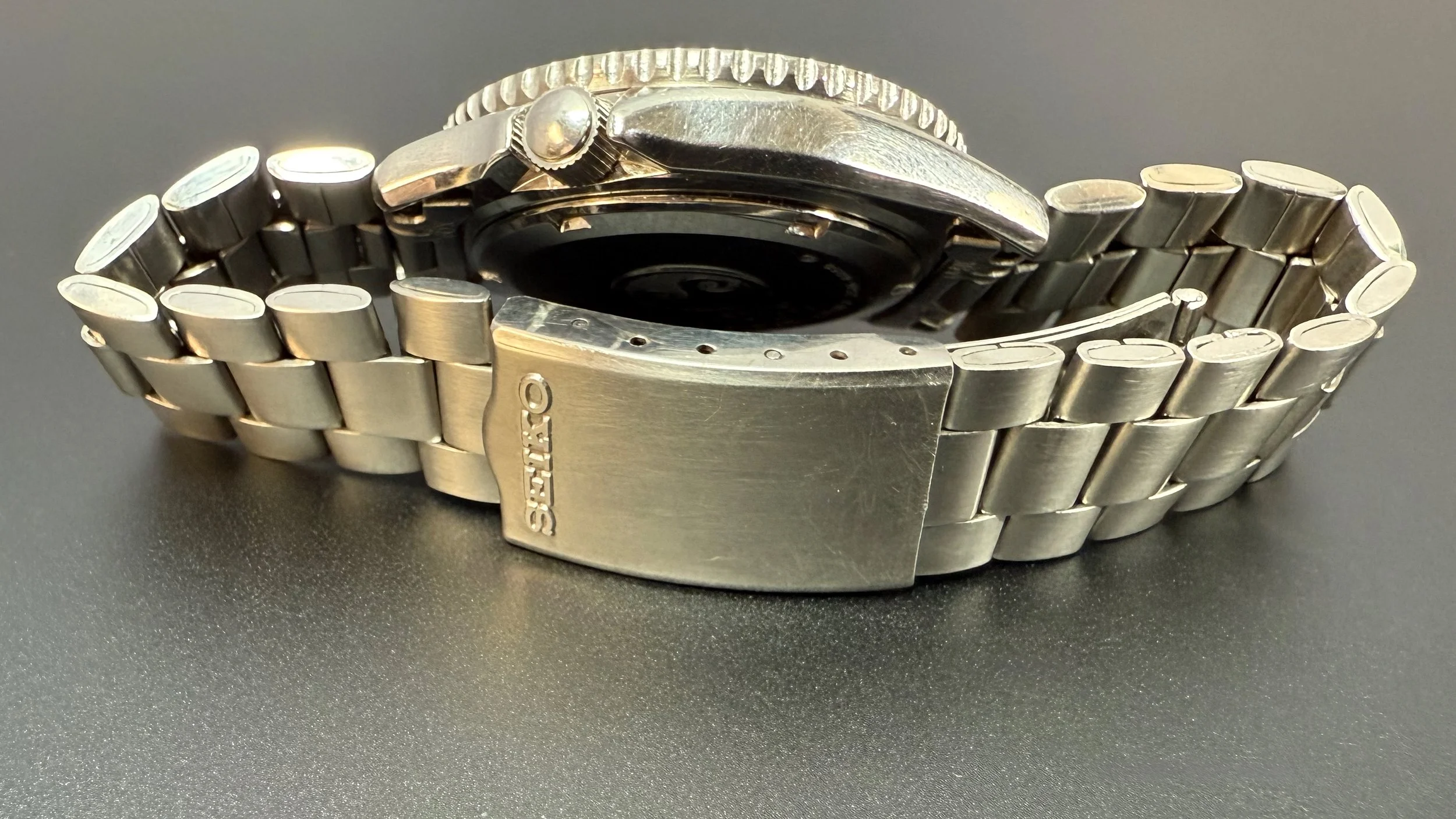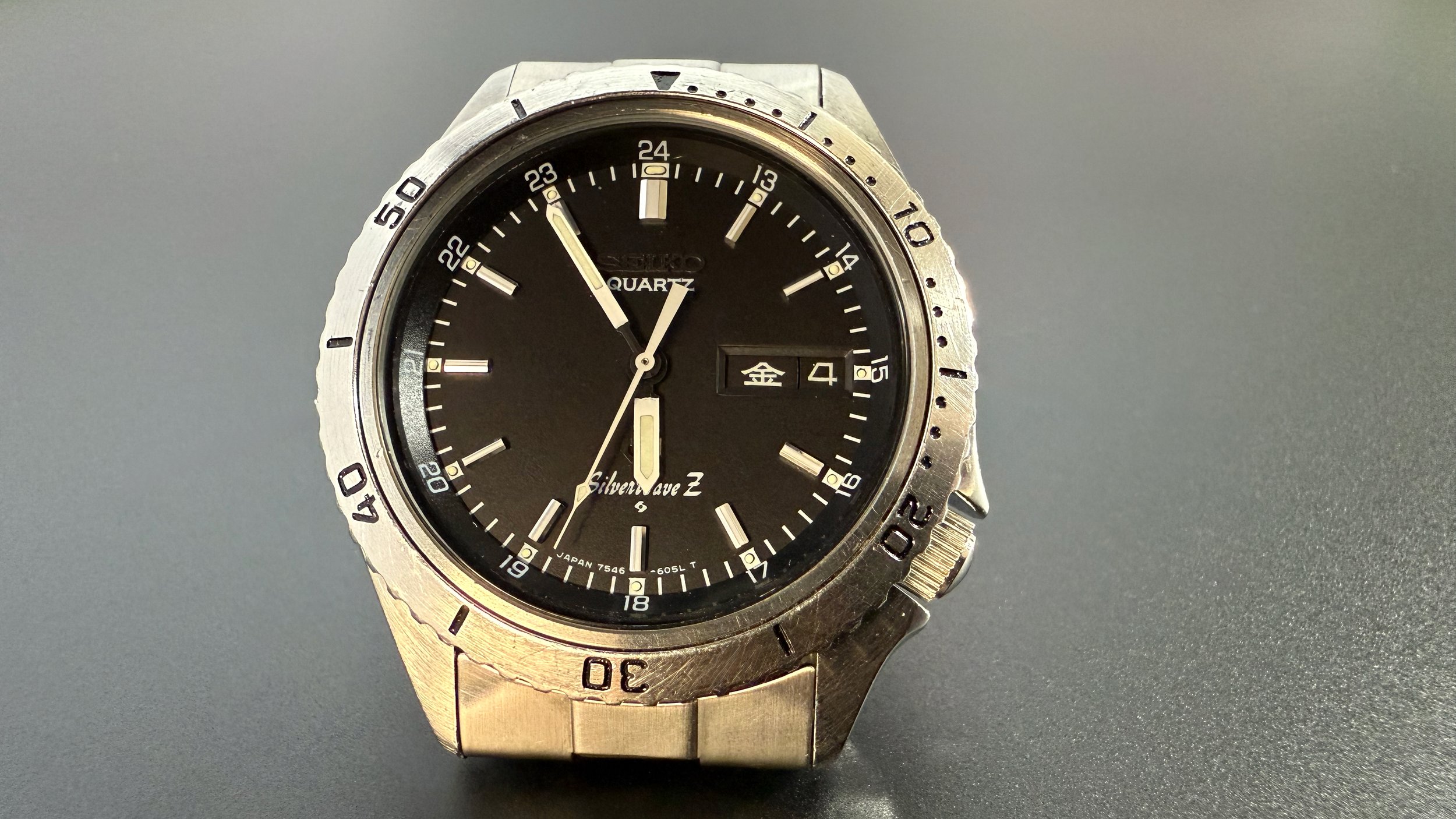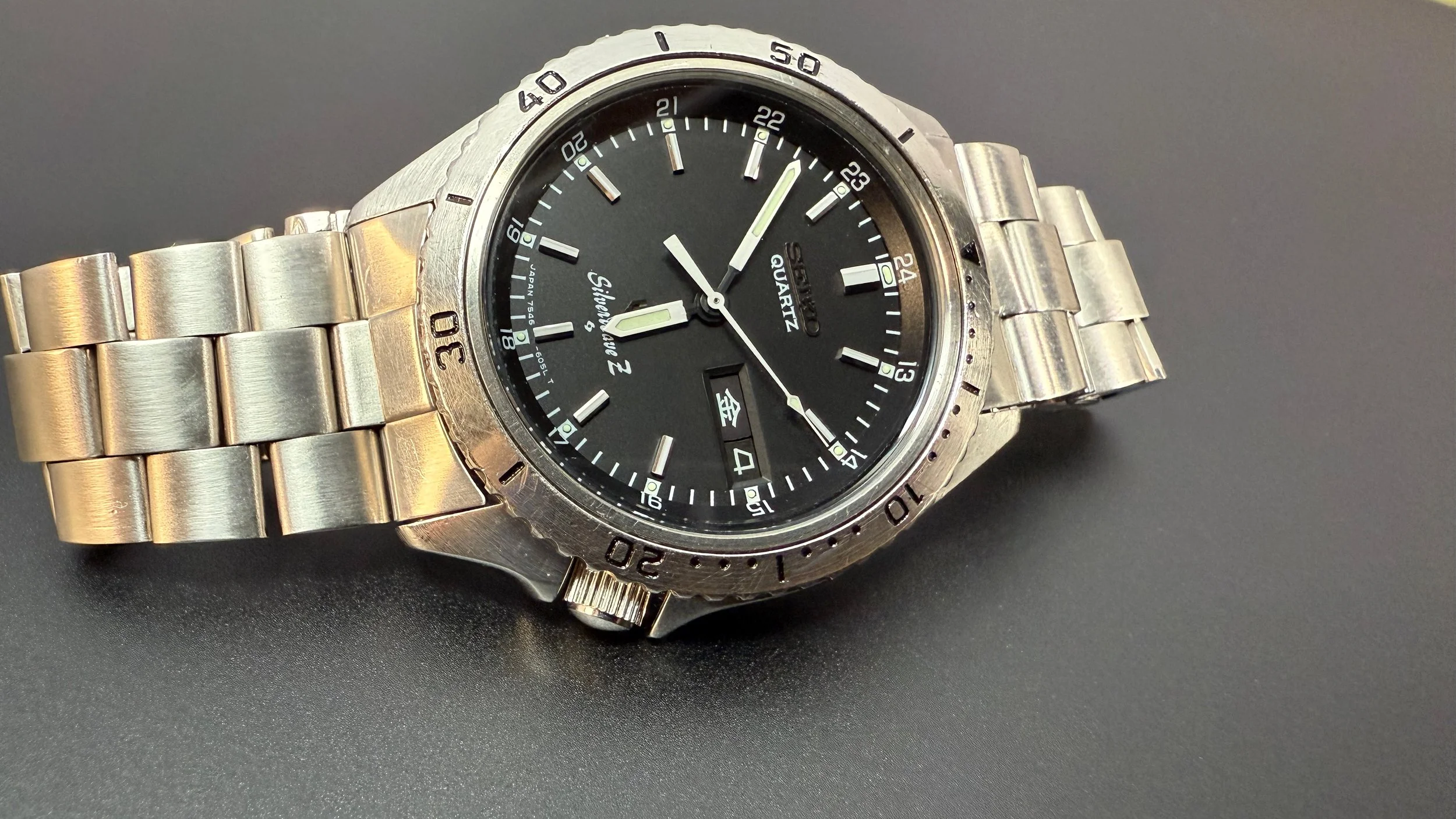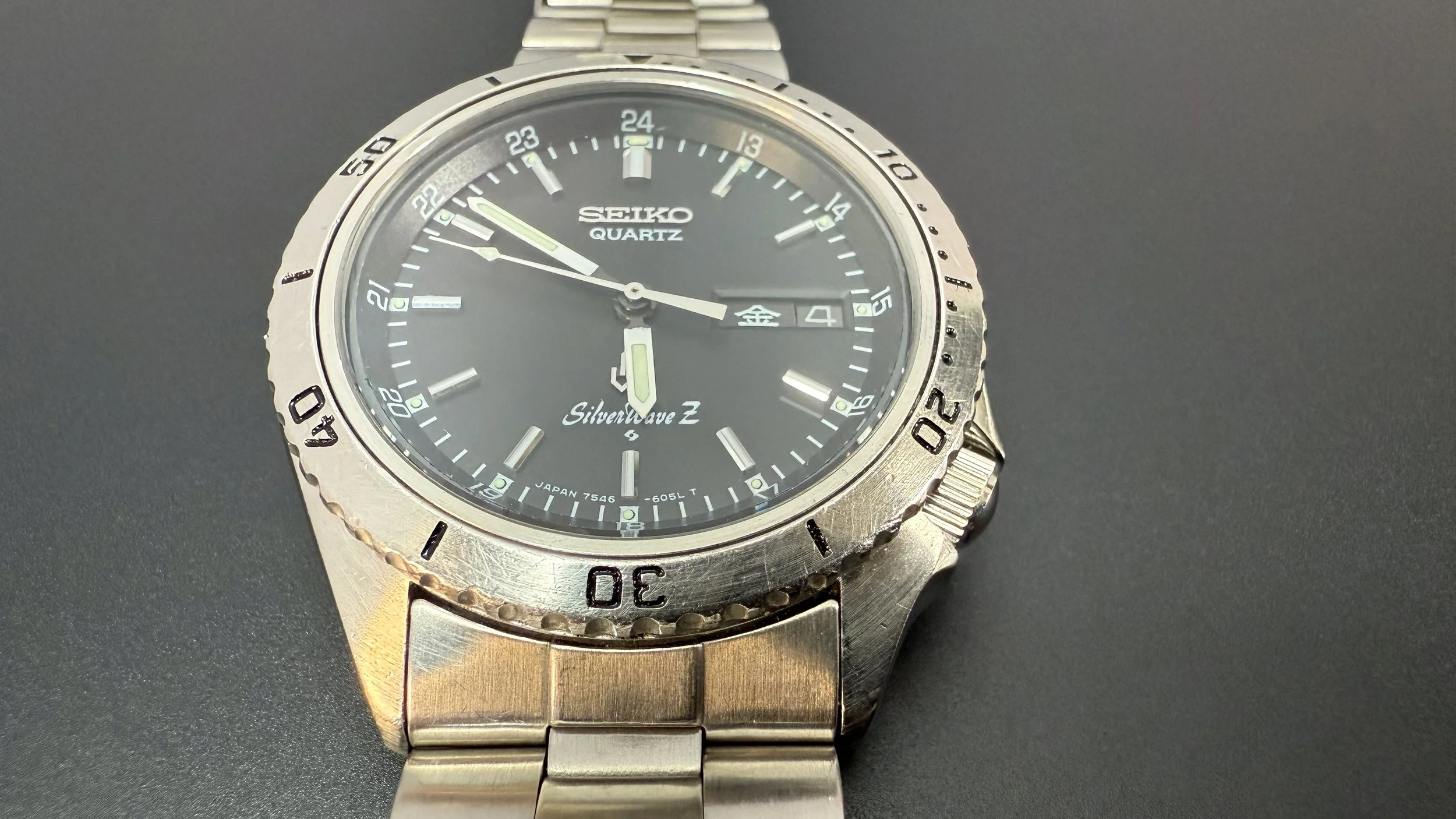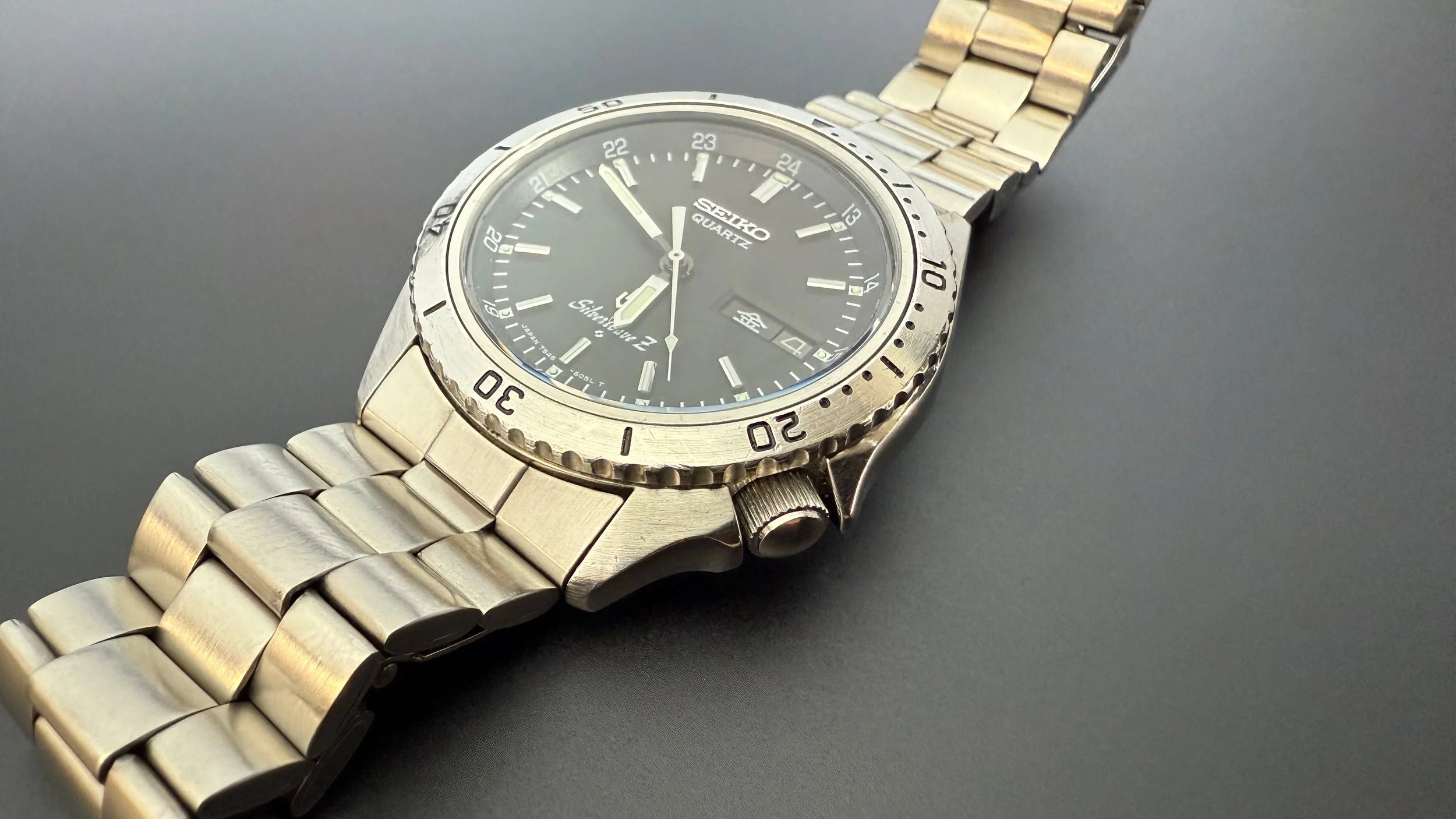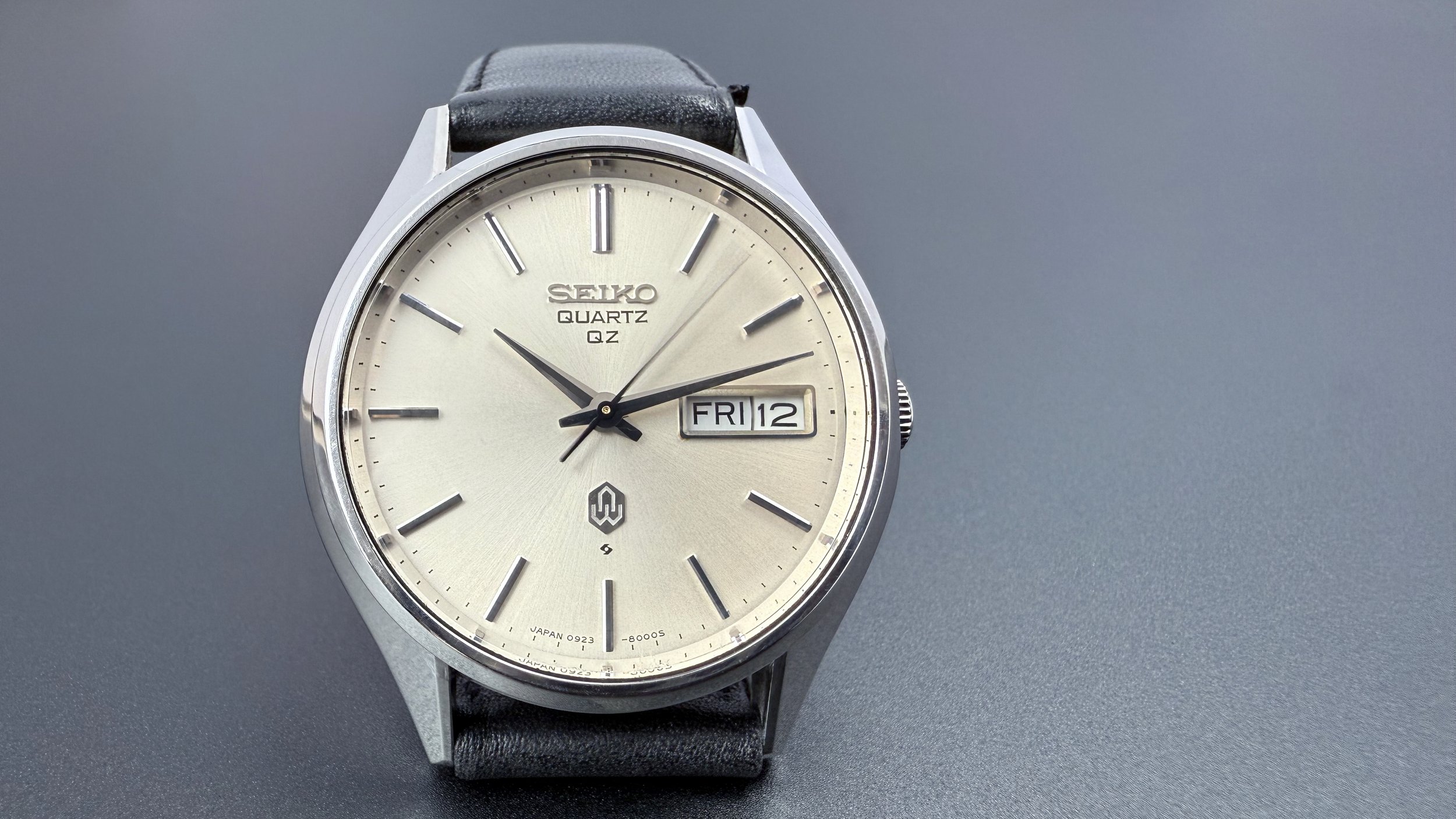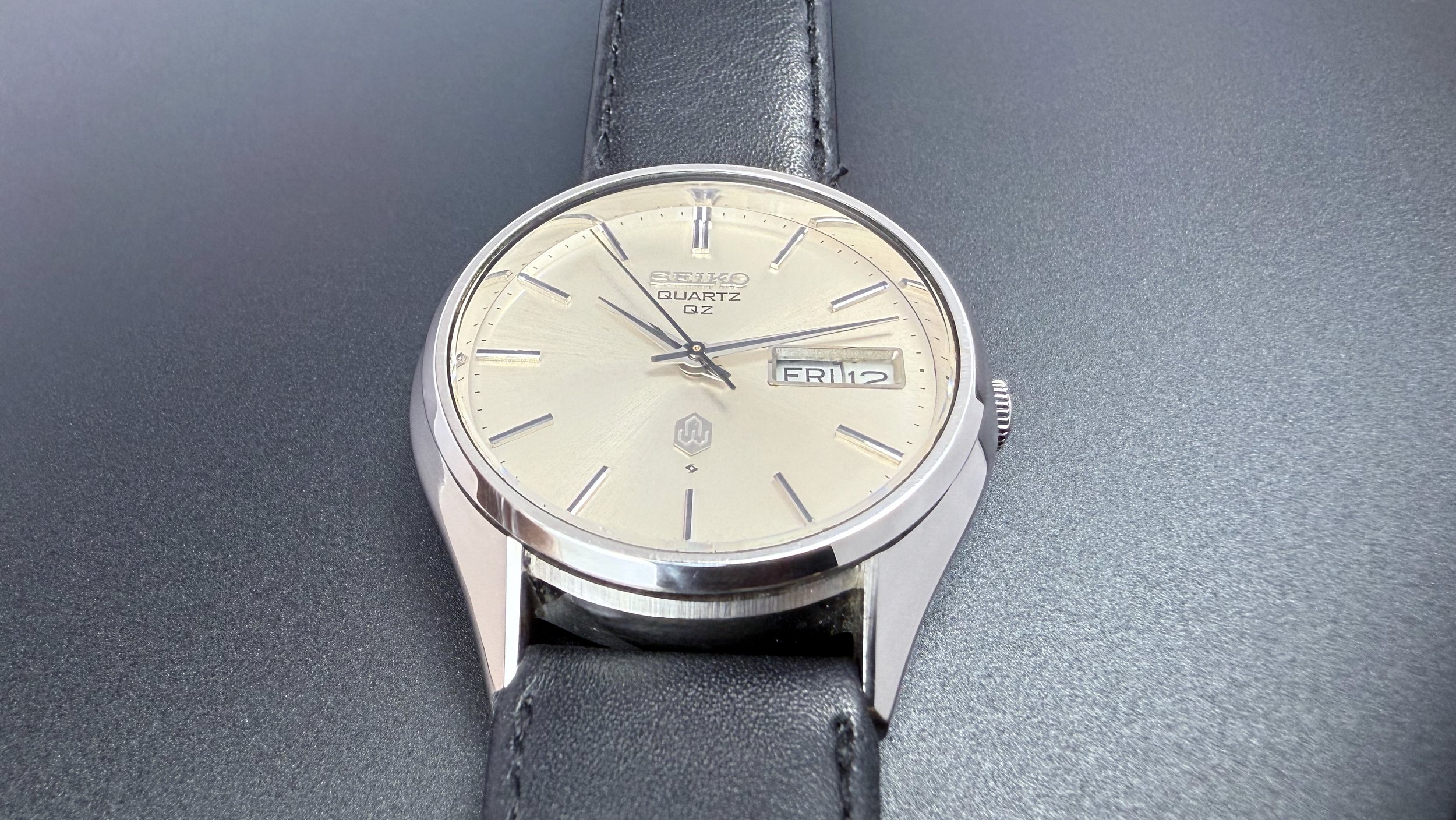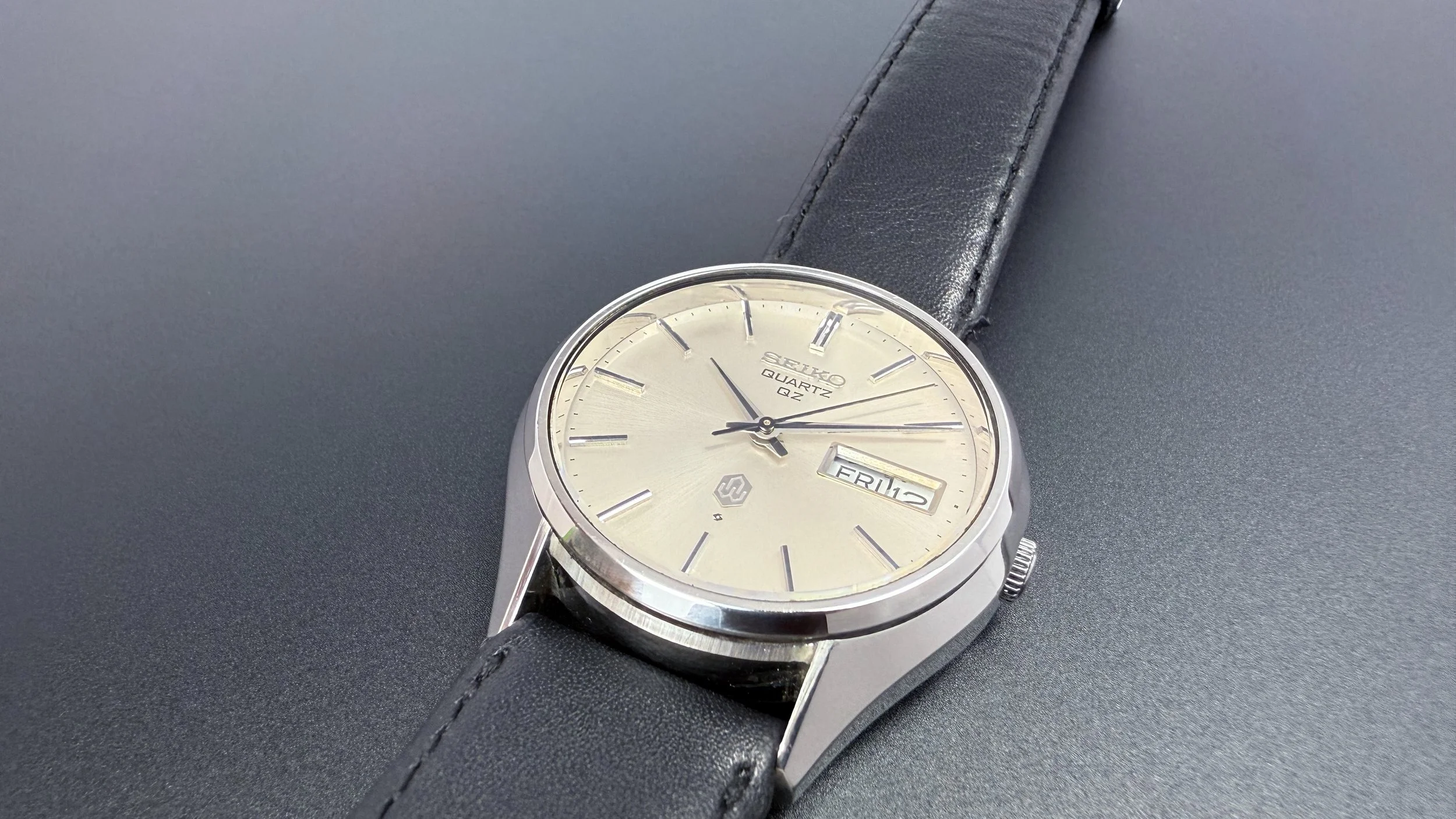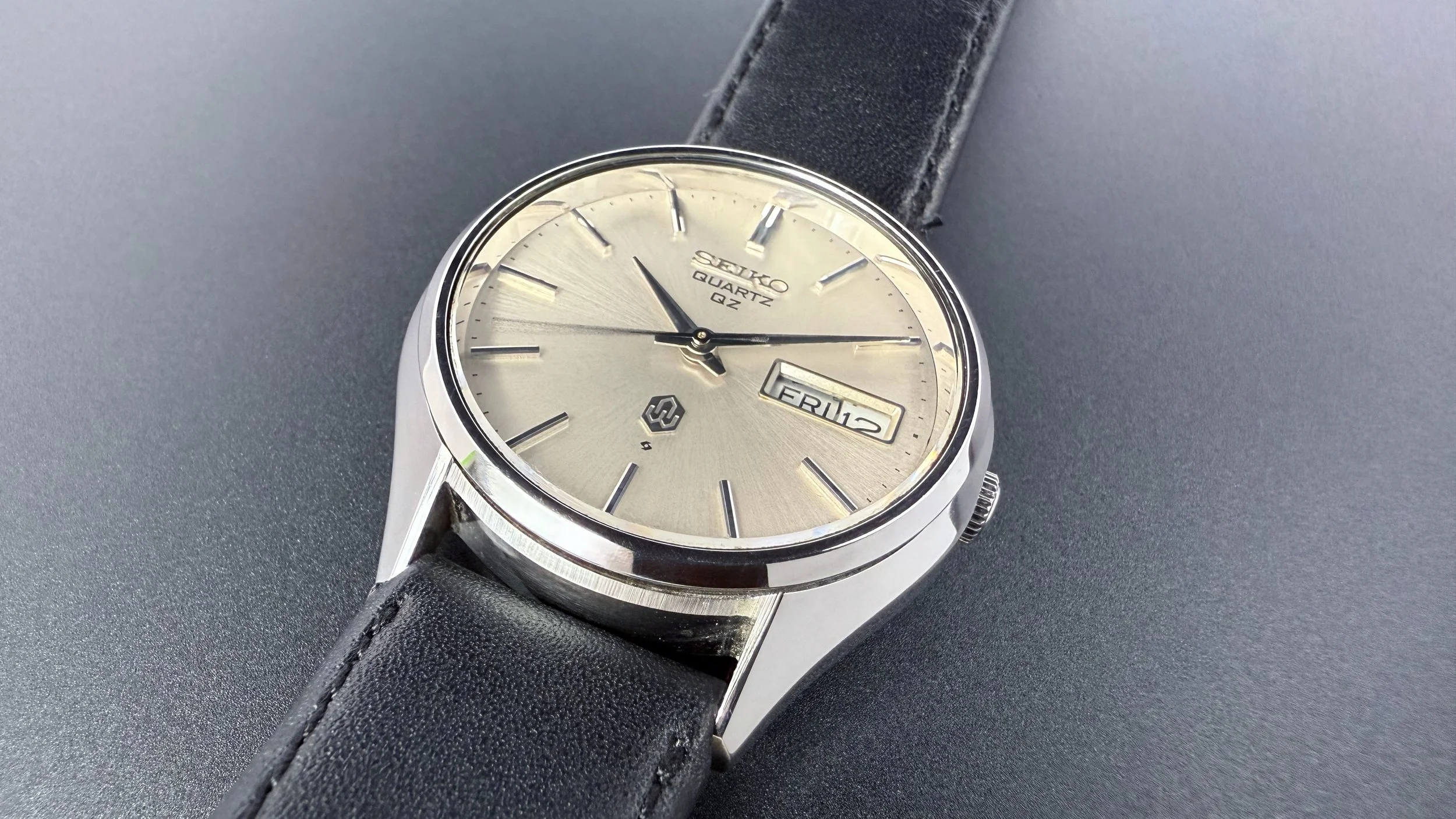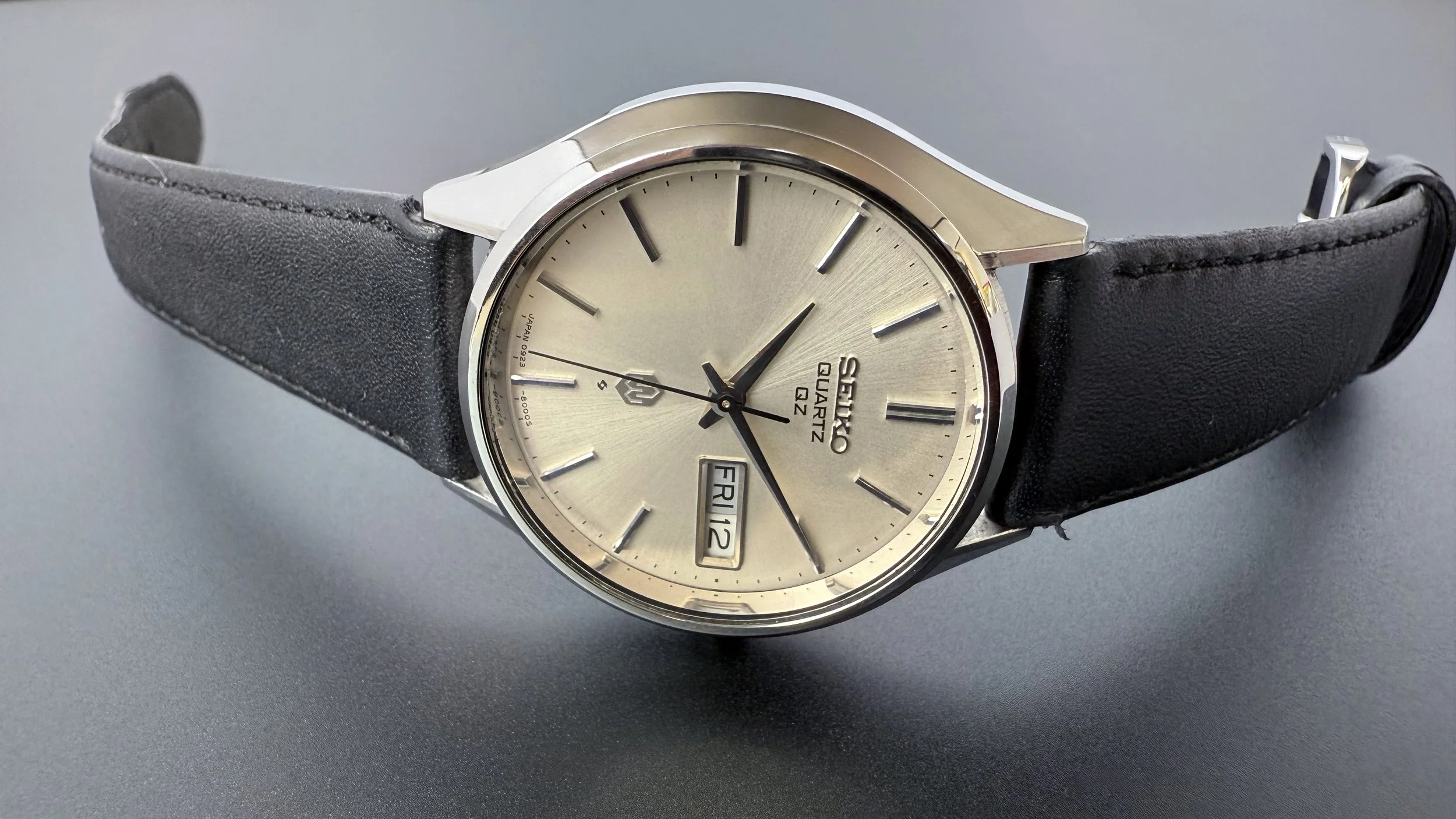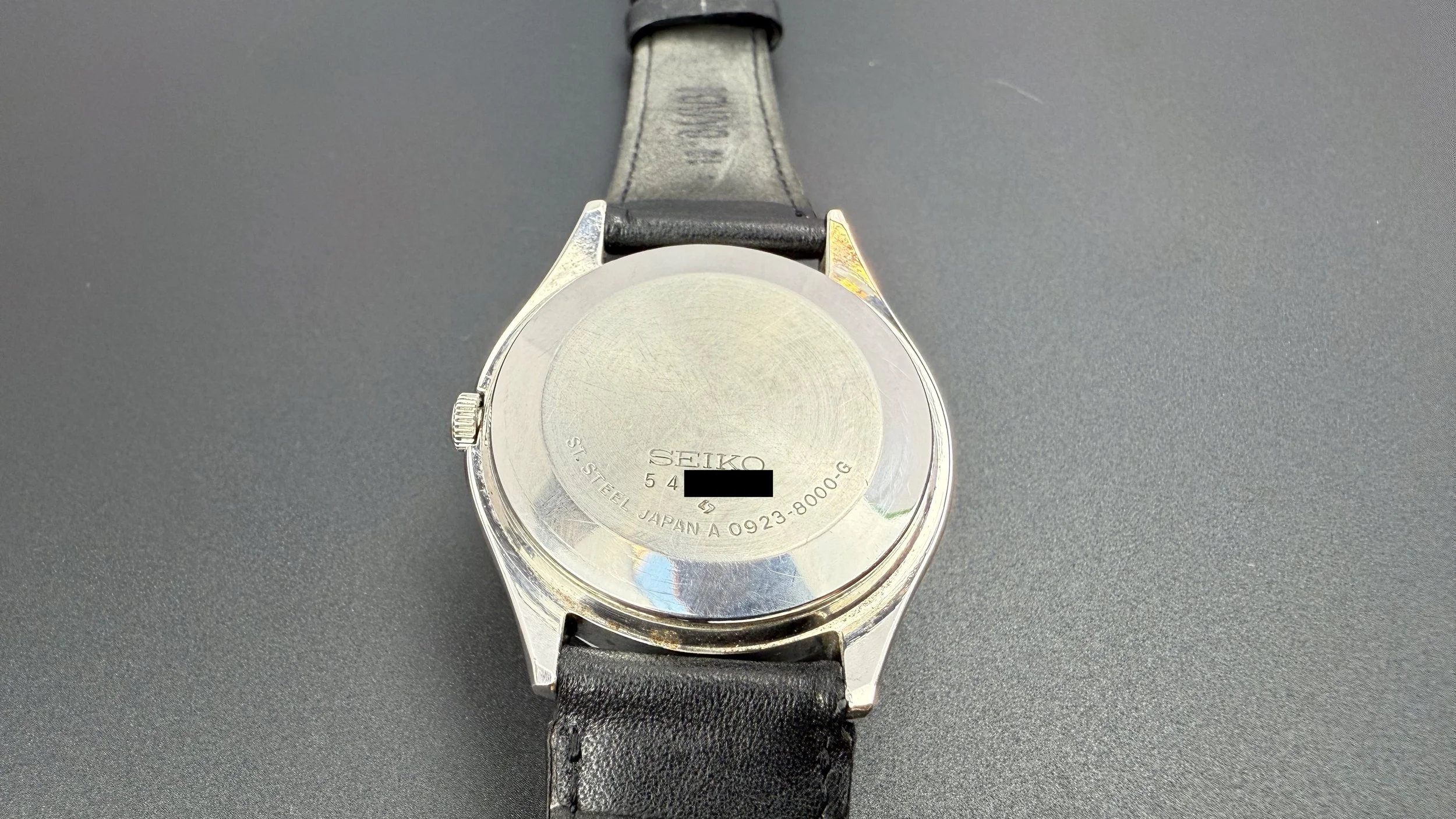The Seiko Silverwave Quartz: A Rugged ‘70s Experiment in Durability
With a wide variety of calibers, the Seiko Silverwave Quartz was a notable presence throughout the 1970s. Priced at about half the cost of a King Seiko but above the Type II line, the Silverwave offered a unique value proposition. A movement like the 6030, housed in a Silverwave case, was considered significantly more robust than when used in the Type II. This made the Silverwave one of Seiko’s early attempts to create a water-resistant watch that could also withstand physical impact.
The distinctive tsunami logo on the caseback highlights this focus on water resistance. First seen on early Silverwave models, the logo has become a recognizable feature on many of Seiko’s waterproof and dive watches—from vintage models to today’s Prospex line.
For collectors, the tsunami logo appears in several variations, from small one- or two-wave designs to fully rendered realistic waves. A good rule of thumb is: the bigger and more detailed the wave, the better the watch’s water resistance and performance. All certified Seiko diver’s watches feature the full tsunami wave on the case back.
So what defines a Silverwave? It’s all about the case construction. You can expect a screw-down crown at 3 or 4 o’clock (often with crown guards), a screw-in caseback, and sometimes even a unidirectional bezel. Most other quartz watches of the time didn’t offer such features, often having a battery hatch and a push-pull crown.
Dial readability was also a priority—especially at night. Some Silverwave models feature fully lumed markers and hands, and even a lume-tipped seconds hand, a design cue typically found in diver’s watches. Of course the ana-digi silverwaves mostly had a button to light up the dial.
The Seiko H557-537L is such a watch, inspired by Bond’s G757-5020. When James Bond wore the Seiko G757 Sports 100 in the 1983 film Octopussy, collectors took notice. With its high-tech digital display and rugged horseshoe-shaped case, the G757-5020 has become a collector’s grail—rare, screen-worn, and often commanding prices well over $1,000. But for those who admire early Seiko tech design without the Hollywood price tag, there’s an underrated alternative: the Seiko H557-537L.
Not Bond’s Watch, But Close Enough
While the H557-537L didn’t appear in Octopussy, it shares many visual and technical similarities with the G757:
Both were designed in the early 1980s by Seiko’s innovative quartz division.
Both offer dual time functionality via analog-digital displays.
Both include alarms, chronographs, and backlit LCDs—decades before smartwatches existed.
Most importantly, both capture the tactical, utilitarian feel that defined Seiko’s tech-forward era.
Design DNA: Analog Meets Digital
The H557-537L combines the clarity of analog timekeeping with digital versatility in a compact, rectangular case. Its black dial with sharp white markers echoes the G757’s utilitarian aesthetic, while the digital display sits subtly below the analog hands—adding function without distraction. The result is a watch that feels just as espionage-ready, but with a more refined and low-profile look.
Collectors drawn to the Bond connection will immediately appreciate the H557. It channels the G757 spirit, but adds everyday wearability and elegance. Think of it as Bond’s weekend watch—less action, more leisure.
Affordable, Authentic, and Underrated
G757 prices continue to rise due to scarcity and film fame. The H557-537L, however, remains relatively affordable—despite sharing the same design ethos, technological foundation, and full Seiko pedigree.
It’s an ideal choice for those who:
Are starting a Seiko tech-era collection
Want a Bond-inspired model without the movie-premium
Need a vintage piece that’s both collectible and wearable
Conclusion: The Smart Collector’s Bond
If you love the story behind the G757 but can’t justify the cost—or just want to add a second Seiko to your vintage rotation—the Seiko H557-537L is a fantastic alternative. It brings together nostalgia, functionality, and 1980s Seiko charm—delivering Bond-level cool, without the MI6 budget.
The Seiko Silverwave Quartz: A Rugged ‘70s Experiment in Durability
With a wide variety of calibers, the Seiko Silverwave Quartz was a notable presence throughout the 1970s. Priced at about half the cost of a King Seiko but above the Type II line, the Silverwave offered a unique value proposition. A movement like the 6030, housed in a Silverwave case, was considered significantly more robust than when used in the Type II. This made the Silverwave one of Seiko’s early attempts to create a water-resistant watch that could also withstand physical impact.
The distinctive tsunami logo on the caseback highlights this focus on water resistance. First seen on early Silverwave models, the logo has become a recognizable feature on many of Seiko’s waterproof and dive watches—from vintage models to today’s Prospex line.
For collectors, the tsunami logo appears in several variations, from small one- or two-wave designs to fully rendered realistic waves. A good rule of thumb is: the bigger and more detailed the wave, the better the watch’s water resistance and performance. All certified Seiko diver’s watches feature the full tsunami wave on the case back.
So what defines a Silverwave? It’s all about the case construction. You can expect a screw-down crown at 3 or 4 o’clock (often with crown guards), a screw-in caseback, and sometimes even a unidirectional bezel. Most other quartz watches of the time didn’t offer such features, often having a battery hatch and a push-pull crown.
Dial readability was also a priority—especially at night. Some Silverwave models feature fully lumed markers and hands, and even a lume-tipped seconds hand, a design cue typically found in diver’s watches. Of course the ana-digi silverwaves mostly had a button to light up the dial.
The Seiko H557-537L is such a watch, inspired by Bond’s G757-5020. When James Bond wore the Seiko G757 Sports 100 in the 1983 film Octopussy, collectors took notice. With its high-tech digital display and rugged horseshoe-shaped case, the G757-5020 has become a collector’s grail—rare, screen-worn, and often commanding prices well over $1,000. But for those who admire early Seiko tech design without the Hollywood price tag, there’s an underrated alternative: the Seiko H557-537L.
Not Bond’s Watch, But Close Enough
While the H557-537L didn’t appear in Octopussy, it shares many visual and technical similarities with the G757:
Both were designed in the early 1980s by Seiko’s innovative quartz division.
Both offer dual time functionality via analog-digital displays.
Both include alarms, chronographs, and backlit LCDs—decades before smartwatches existed.
Most importantly, both capture the tactical, utilitarian feel that defined Seiko’s tech-forward era.
Design DNA: Analog Meets Digital
The H557-537L combines the clarity of analog timekeeping with digital versatility in a compact, rectangular case. Its black dial with sharp white markers echoes the G757’s utilitarian aesthetic, while the digital display sits subtly below the analog hands—adding function without distraction. The result is a watch that feels just as espionage-ready, but with a more refined and low-profile look.
Collectors drawn to the Bond connection will immediately appreciate the H557. It channels the G757 spirit, but adds everyday wearability and elegance. Think of it as Bond’s weekend watch—less action, more leisure.
Affordable, Authentic, and Underrated
G757 prices continue to rise due to scarcity and film fame. The H557-537L, however, remains relatively affordable—despite sharing the same design ethos, technological foundation, and full Seiko pedigree.
It’s an ideal choice for those who:
Are starting a Seiko tech-era collection
Want a Bond-inspired model without the movie-premium
Need a vintage piece that’s both collectible and wearable
Conclusion: The Smart Collector’s Bond
If you love the story behind the G757 but can’t justify the cost—or just want to add a second Seiko to your vintage rotation—the Seiko H557-537L is a fantastic alternative. It brings together nostalgia, functionality, and 1980s Seiko charm—delivering Bond-level cool, without the MI6 budget.













